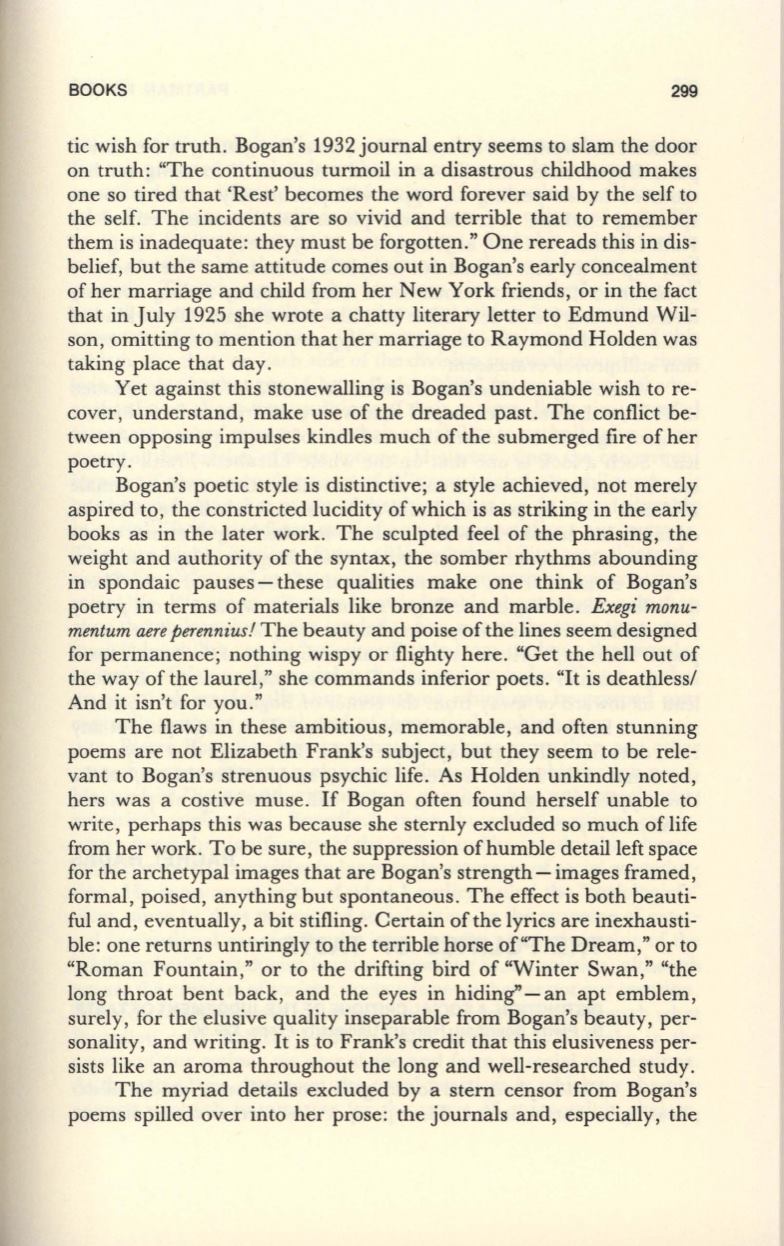
BOOKS
299
tic wish for truth. Bogan's 1932 journal entry seems to slam the door
on truth: "The continuous turmoil in a disastrous childhood makes
one so tired that 'Rest' becomes the word forever said by the self to
the self. The incidents are so vivid and terrible that to remember
them is inadequate: they must be forgotten." One rereads this in dis–
belief, but the same attitude comes out in Bogan's early concealment
of her marriage and child from her New York friends, or in the fact
that in July 1925 she wrote a chatty literary letter to Edmund Wil–
son, omitting to mention that her marriage to Raymond Holden was
taking place that day .
Yet against this stonewalling is Bogan's undeniable wish to re–
cover, understand, make use of the dreaded past. The conflict be–
tween opposing impulses kindles much of the submerged fire of her
poetry.
Bogan's poetic style is distinctive; a style achieved, not merely
aspired to, the constricted lucidity of which is as striking in the early
books as in the later work. The sculpted feel of the phrasing, the
weight and authority of the syntax, the somber rhythms abounding
in spondaic pauses - these qualities make one think of Bogan's
poetry in terms of materials like bronze and marble.
Exegi monu–
mentum aere perennius.l
The beauty and poise of the lines seem designed
for permanence; nothing wispy or flighty here. "Get the hell out of
the way of the laurel," she commands inferior poets.
"It
is deathless/
And it isn't for you."
The flaws in these ambitious, memorable, and often stunning
poems are not Elizabeth Frank's subject, but they seem to be rele–
vant to Bogan's strenuous psychic life. As Holden unkindly noted,
hers was a costive muse .
If
Bogan often found herself unable to
write, perhaps this was because she sternly excluded so much of life
from her work. To be sure, the suppression of humble detail left space
for the archetypal images that are Bogan's strength - images framed,
formal, poised, anything but spontaneous. The effect is both beauti–
ful and, eventually, a bit stifling. Certain of the lyrics are inexhausti–
ble: one returns untiringly to the terrible horse of "The Dream," or to
"Roman Fountain," or to the drifting bird of "Winter Swan," "the
long throat bent back, and the eyes in hiding" - an apt emblem,
surely, for the elusive quality inseparable from Bogan's beauty, per–
sonality, and writing. It is to Frank's credit that this elusiveness per–
sists like an aroma throughout the long and well-researched study.
The myriad details excluded by a stern censor from Bogan's
poems spilled over into her prose: the journals and, especially, the


